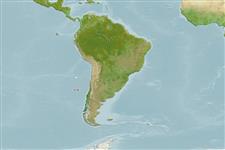Malacostraca |
Decapoda |
Palinuridae
Environment: milieu / climate zone / गहराई सीमा / distribution range
पारिस्थितिकी
; गहराई सीमा 2 - 200 m (संदर्भ 4). Subtropical, preferred 18°C (संदर्भ 107945); 26°S - 34°S, 81°W - 77°W (संदर्भ 4)
Southeast Pacific: Juan Fernandez and Desventuradas Island.
Length at first maturity / आकार / Weight / Age
परिपक्व अवधि: Lm ? range ? - ? cm Max length : 48.0 cm BL पुल्लिंग / अलिंग; (संदर्भ 4); 46 cm BL (female)
It has a maximum body length of 48 cm (male) and 46 cm (female); and carapace lengths of 22 cm (male) and 19 cm (female); Reports of total body lengths of 60 to 70 cm have to be considered with much reserve (Ref. 4). Occurs at depths of 2 to 200 m and inhabits a rocky partly sandy environment. Feeds on algae, smaller and larger mollusks, crustaceans and dead animal matter of any kind. There is some migration to deeper waters from the end of September onwards, the species never disappears completely from the coast. In January, the migration back to shallow water starts. Preyed on by various fishes (Ref. 4).
Life cycle and mating behavior
परिपक्व अवधि | पुनरुत्पत्ति | मछलीऔ का अंडे देना | Eggs | Fecundity | Larvae
Eggs spawned between August and November and carried for about 11 months.
Holthuis, L.B. 1991 FAO Species Catalogue. Vol. 13. Marine lobsters of the world. An annotated and illustrated catalogue of species of interest to fisheries known to date. FAO Fish. Synop. 125(13):292p. Rome: FAO. (संदर्भ 4)
IUCN Red List Status
(संदर्भ 130435: Version 2025-1)
CITES status (संदर्भ 108899)
Not Evaluated
CMS (संदर्भ 116361)
Not Evaluated
Threat to humans
Human uses
मात्स्यिकी: व्यापारिक
FAO - मात्स्यिकी: landings | FishSource | Sea Around Us
साधन
अधिक जानकारी
Population dynamicsबाढ़
Max. ages / sizes
Length-weight rel.
Length-length rel.
Length-frequencies
Mass conversion
बहुतायत
Life cycleपुनरुत्पत्तिपरिपक्व अवधिFecundityमछलीऔ का अंडे देनाEggsEgg developmentLarvae PhysiologyOxygen consumption
Human RelatedStamps, coins, misc.
इंटरनेट स्रोत
Estimates based on models
Fishing Vulnerability
Moderate vulnerability (38 of 100).
Climate Vulnerability
High to very high vulnerability (72 of 100).
Nutrients : Calcium = 109 [35, 184] mg/100g; Iron = 1.59 [1.21, 1.97] mg/100g; Protein = 20.2 [19.2, 21.3] %; Omega3 = 0.285 [0.185, 0.386] g/100g; Selenium = 48.3 [-31.7, 128.3] μg/100g; VitaminA = 0 μg/100g; Zinc = 1.79 [1.17, 2.40] mg/100g (wet weight); based on
nutrient studies.
